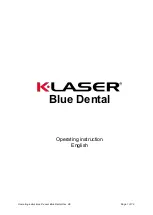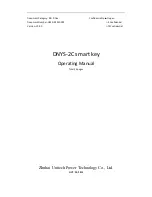
p
WARNING!
Ensure you read, understand and apply the safety and operational
instructions before connecting the tester clamps to the battery. Only when you are
sure that you understand the procedures is it safe to proceed with the testing process.
p
WARNING!
Variable load carbon pile battery testers produce heat when in use. Take
care to allow sufficient time to cool down between tests to avoid injury due to heat
build up.
p
WARNING!
Ensure that the rotary load control is in the OFF position before
attaching or removing clamps to prevent arcing or potential explosion from
battery gases. Wear eye protection and gloves during the testing process.
3.1.
PREPARATION.
3.1.1.
Check battery casing for cracks or leakage and confirm that it is 12 volts.
3.1.2.
Clean battery terminals.
3.1.3.
If possible, check electrolyte levels and top up with distilled water as necessary.
3.2.
BATTERY LOAD TEST.
p
WARNING!
Ensure vehicle, or battery, is in a well ventilated area before starting to test.
NOTE: On the first load test smoke may be emitted from the louvres in the tester casing. This is oil burning off the load bank and is normal.
3.2.1.
Use the tester horizontally. (i.e. lay it on its back.)
3.2.2
Ensure that the load is OFF by rotating the load control fully anticlockwise.
3.2.3.
Attach positive (red) clamp to positive (+) battery terminal and negative (black) clamp to negative (-) terminal. Slightly twist clamps on terminals two or
three times to ensure a good electrical contact and a firm grip.
3.2.4.
Ensure that the clamp cables are clear of hot or moving engine parts, particularly if a starter or charging test is to be carried out. Ventilation slots in tester
casing should be unobstructed, meters should be easily visible and load control accessible.
3.2.5
Check the battery charge condition by referring to the centre scale on the volt meter. If the indicator needle is in the green area it is safe to proceed with
the load test. If the indicator needle is in the red area the battery should be charged before performing the load test.
1.1.
PERSONAL PRECAUTIONS
3
Ensure there is another person within hearing range of your voice and close enough to come to your aid, should a problem
arise when working near a lead-acid battery.
3
Wear safety eye protection and protective clothing. Avoid touching eyes while working near battery.
3
Have fresh water and soap nearby in case battery acid contacts skin, clothing, or eyes.
3
Wash immediately with soap and water if battery acid contacts skin or clothing. If acid enters eye, flush eye immediately with cool, clean
running water for at least 15 minutes and seek immediate medical attention.
3
Remove personal metallic items such as rings, bracelets, necklaces and watches. A lead-acid battery can produce a short-circuit current
which is high enough to weld a ring or the like to metal, which would cause severe burns.
3
Ensure hands, clothing (especially belts) are clear of fan blades and other moving or hot parts of engine, remove ties and contain long hair.
7
DO NOT
smoke or allow a spark or flame in the vicinity of battery or engine.
1.2. GENERAL SAFETY INSTRUCTIONS
3
Familiarise yourself with the application and limitations of the tester as well as the potential hazards. Also refer to the vehicle manufacturers hand book.
IF IN
ANY DOUBT CONSULT AN ELECTRICIAN.
3
Ensure the tester is in good order and condition before use. If in any doubt do not use the unit and contact an electrician.
3
Only use recommended attachments and parts. To use non-recommended items may be dangerous and will invalidate your warranty.
3
Ensure the tester load switch is Off
before
attaching/detaching the power clamps to/from the battery terminals.
3
Keep tools and other items away from the engine and ensure you can see the battery and working parts of engine clearly.
3
Confirm that the battery to be tested is 12 volt
and not 6 or 24 volt
before attaching clamps to battery terminals.
3
If the tester receives a sharp knock or blow the unit must be checked by a qualified service agent before using.
3
If the battery terminals are corroded or dirty, clean them before attaching the clamps.
3
Keep children and unauthorised persons away from the working area.
7
DO NOT
dis-assemble the tester for any reason. The tester must only be checked by qualified service personnel.
p
WARNING!
To prevent the risk of sparking, short circuit and possible explosion
DO NOT
drop metal tools in the battery area, or allow them to touch the battery terminals.
7
DO NOT
cross connect leads from tester to battery. Ensure positive (+/RED) is to positive and negative (-/BLACK) is to negative. If symbols cannot be
distinguished, remember that the negative terminal is the one directly connected to the vehicle bodywork.
7
DO NOT
pull the cables or clamps from the battery terminals.
7
DO NOT
use the tester outdoors, or in damp, or wet locations and
DO NOT
use within the vicinity of flammable liquids or gases.
3
Ensure there is effective ventilation to prevent a build-up of explosive gases, and do not cover or obstruct tester ventilation louvres.
7
DO NOT
use the tester for a task for which it is not designed.
3
When not in use, store the tester carefully in a safe, dry, childproof location.
INSTRUCTIONS FOR:
12V BATTERY TESTER
MODEL:
BT91/11
Thank you for purchasing a Sealey product. Manufactured to a high standard this product will, if used according to these instructions
and properly maintained, give you years of trouble free performance.
1. SAFETY INSTRUCTIONS
IMPORTANT:
PLEASE READ THESE INSTRUCTIONS CAREFULLY. NOTE THE SAFE OPERATIONAL REQUIREMENTS, WARNINGS & CAUTIONS. USE THE PRODUCT
CORRECTLY AND WITH CARE FOR THE PURPOSE FOR WHICH IT IS INTENDED. FAILURE TO DO SO MAY CAUSE DAMAGE AND/OR PERSONAL INJURY AND WILL
INVALIDATE THE WARRANTY. PLEASE KEEP INSTRUCTIONS SAFE FOR FUTURE USE.
DANGER! BE AWARE, LEAD-ACID BATTERIES GENERATE EXPLOSIVE GASES DURING NORMAL BATTERY OPERATION. FOR THIS REASON, IT IS
VERY IMPORTANT TO READ AND FOLLOW THESE INSTRUCTIONS CAREFULLY, EACH TIME YOU USE THE BATTERY TESTER.
Follow these instructions and those published by the battery and vehicle manufacturers, and the maker of any equipment you intend to use in the
vicinity of the battery. Remember to review warning marks on all products and on engines.
The BT91/11 has a steel case with heavy-duty copper cable and clamps. Dual, large sized, moving coil meters are
reliable and easy to read. Suitable for testing 12Volt batteries, alternators, regulators and starters.
VOLTAGE RANGE: 0 - 16V (12V Batteries)
CAPACITY RANGE: 0 - 160Ah, 0 - 1000CCA, 0 - 500A
3. OPERATION
2. INTRODUCTION & SPECIFICATION
BT91/11 - 1 - 071204




















